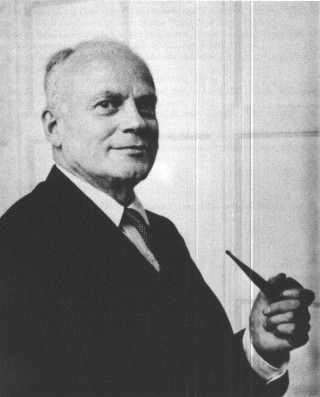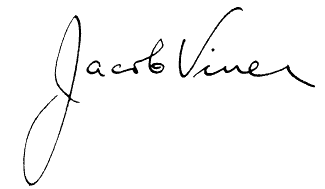| Profile | Major Works | Resources |
Jacob Viner, 1892-1970.


Together with Knight, the Canadian-born Jacob Viner was the leading light of the Chicago School of the inter-war period. His work ranged all over economics, but it is perhaps his work on the history of economic thought and international trade theory that we find his remarkable strengths. Nonetheless, as Robbins characterized him, Viner was "the outstanding all-rounder of his time in our profession" (Robbins, 1970: p.2).
Born in Montreal, Canada, Jacob Viner obtained his B.A. from McGill in 1914, and his Ph.D. from Harvard in 1922, under Frank Taussig Although an instructor since 1916, Viner formally joined the faculty at the University of Chicago in 1925, where he remained until 1946, when he moved to Princeton.
Jacob Viner's very first publication was on methodology (1917), in which he provided a full-fledged defense of the inductive method. His subsequent work was on problems in trade theory - a concern which he maintained throughout the rest of his career. In International trade, Viner is notable for his work on dumping (1922, 1923) and the "trade diversion" thesis on customs unions (1950).
This work was concurrent with his masterly 1921 and 1931 articles on price theory - the first began inching towards a theory of imperfect competition, the second providing an analytical and graphical exposition of the theory of the firm (the long-run and short-run cost curves we see in modern principles textbooks). A famous error on the long-run envelope of short-run average cost curves in his 1931 article and anticipation by Harrod did not diminish his claim to fame.
Jacob Viner was fiercely opposed to the Keynesian Revolution - but not because of its policy prescriptions as indeed, Viner himself had recommended them. As he wrote in several papers (e.g. 1933), Viner believed the Great Depression was due to deflation in output prices being faster than the collapse in costs. Recovery, he believed, required a restoration of profit margins and thus government-induced inflation - not by monetary expansion, but rather by deficit spending. This would create the necessary price rise (and, with costs lagging, profits) and the consequent cumulative rise in output to pull the economy out of depression. He was very much a fiscal policy advocate and a believer in policy discretion rather than fixed rules - thus he did not take Milton Friedman's attempt to paint him as an "early Monetarist" very well.
Viner's famous 1936 critique of Keynes was not over policy implications but rather a result of theoretical disputes over liquidity preference and what Viner thought was oversimplified theory of effective demand. Viner preferred to famously characterize Keynesian theory as "short-run" analysis while considering Neoclassical theory to be true in the "long-run". It was Viner's scathing 1936 critique that prompted J.M. Keynes to write his famous 1937 QJE article as a response.
Viner's work on ithe history of economic thought began with his 1926 essay on Adam Smith and culminated in his magnum opus, Studies in the Theory of International Trade (1937) - to which we owe most of our knowledge of the Bullionist Controversy in 19th Century Britain - and the masterful introduction to the 1965 reprint of Rae's Life of Adam Smith.
Viner's relations with Knight were cool but respectful. Compared to Knight, Viner was less opposed to quantitative techniques but remained wary of them. A recurring, if pointless, amusement at Chicago was the controversy over cost theory between Knight and Viner - with Knight supporting the Austrian doctrine of opportunity cost and Viner espousing the Marshallian "real cost" theory. This position was, in fact, more than a personal diversion: Viner (1932, 1937), after all, had promoted a "real cost" version of the comparative advantage thesis as opposed to Haberler's "opportunity cost" version or Ohlin's "factor-endowment" version.
Despite being one of the leaders of the Chicago School, Viner left Chicago for Princeton in 1946 - perhaps to the relief of many Chicago first-year students: Viner's "price theory" course was notorious for the terrifying way in which he conducted the classroom discussion. In later years, when questioned as to whether he thought himself part of the Chicago School, his reply was unequivocal:
"I am willing to consider the existence of a `Chicago School' (but not one confined to the economics department and not embracing all of the department) and that this `School' had been in operation, and had won many able disciples, for years before I left Chicago. But at no time was I consciously a member of it, and it is my vague impression that if there was such a school it did not regard me as a member, or at least as a loyal and qualified member" (Letter to Patinkin, Nov. 24, 1969).
Although he missed the Nobel awards, Viner was awarded the American Economic Association prestigious Francis A. Walker Medal in 1962 - the economics' profession's Nobel equivalent prior to 1969.
|
Major works of Jacob Viner
|
|
HET
|
|
Resources on Jacob Viner
|
All rights reserved, GonÁalo L. Fonseca
